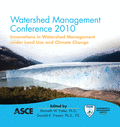Selecting Stormwater (Bio)Filtration Sites and Soil-Based Media
Publication: Watershed Management 2010: Innovations in Watershed Management under Land Use and Climate Change
Abstract
Many research studies have been published regarding the treatment efficiency of bioretention for a wide variety of pollutants found in urban stormwater runoff. However, limited information is available on predicting the treatability of these pollutants between media and between sites. Predicting the treatment ability of bioretention/infiltration/filtration media is a function of both media and water chemistry. This paper begins that meta-analysis of pollutant removal as a function of chemistry. The results presented here are from a single project evaluating candidate bioretention media to meet NPDES numeric effluent limits for industrial stormwater discharges and are based on a limited number of samples. As additional data become available in the spring, the analysis will be expanded. The water chemistry greatly affects the forms of the pollutants, and many metals that are in the dissolved phase have been shown not to be ionic. These complexed metals have valence charges that may make their treatment more difficult. The preliminary results for soil chemistry effects indicate that the media that appear to have the best removal ability for a wide range of metallic pollutants are those that have both cation exchange ability and comparatively high organic matter content; however these chemical characteristics cannot be used to measure media exhaustion, except for the pure ion exchange resins and possibly for ionic forms of the cations. For the removal of the dissolved fraction of metals, this also may require a neutral to acidic media pH because of the generally increased solubility of metals at lower pHs. Lower pHs and higher organic matter contents, however, must be evaluated further if phosphorus removal is also desired since phosphorus is removed better at higher pHs and lower organic matter content (organic matter is a source of P). These results also highlight the trade-offs in pollutant capture versus cation/mineral/pollutant export when using ion-exchange media. Design of bioretention devices for effective treatment, and especially to meet permit limits, requires a greater understanding of the interaction of water and soil chemistry on a site, with a focus on the chemistry of the dissolved fraction.
Get full access to this article
View all available purchase options and get full access to this chapter.
Information & Authors
Information
Published In
Copyright
© 2010 American Society of Civil Engineers.
History
Published online: Apr 26, 2012
Authors
Metrics & Citations
Metrics
Citations
Download citation
If you have the appropriate software installed, you can download article citation data to the citation manager of your choice. Simply select your manager software from the list below and click Download.
